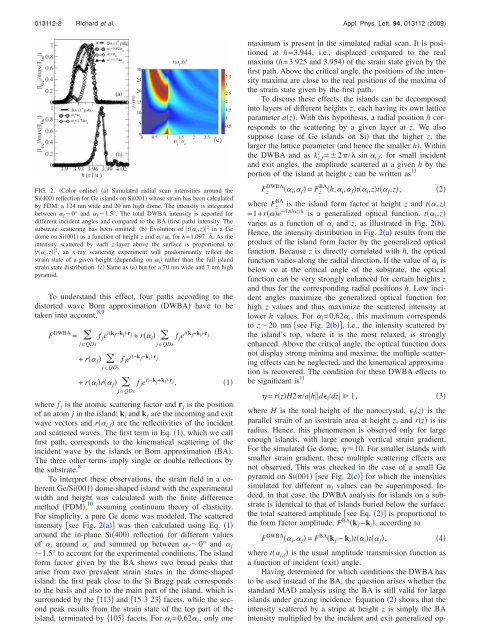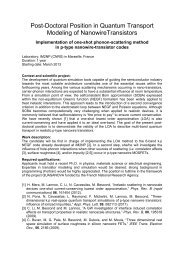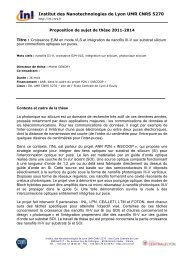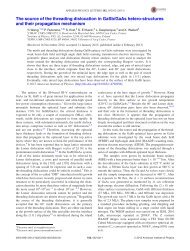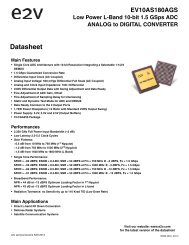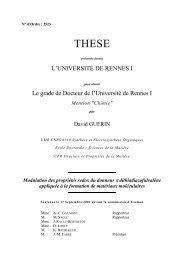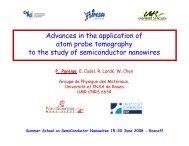Multiple scattering effects in strain and composition analysis ... - IEMN
Multiple scattering effects in strain and composition analysis ... - IEMN
Multiple scattering effects in strain and composition analysis ... - IEMN
Create successful ePaper yourself
Turn your PDF publications into a flip-book with our unique Google optimized e-Paper software.
013112-2 Richard et al. Appl. Phys. Lett. 94, 013112 2009<br />
FIG. 2. Color onl<strong>in</strong>e a Simulated radial scan <strong>in</strong>tensities around the<br />
Si400 reflection for Ge isl<strong>and</strong>s on Si001 whose stra<strong>in</strong> has been calculated<br />
by FDM: a 124 nm wide <strong>and</strong> 20 nm high dome. The <strong>in</strong>tensity is <strong>in</strong>tegrated<br />
between f 0° <strong>and</strong> f 1.5°. The total DWBA <strong>in</strong>tensity is reported for<br />
different <strong>in</strong>cident angles <strong>and</strong> compared to the BA first path <strong>in</strong>tensity. The<br />
substrate <strong>scatter<strong>in</strong>g</strong> has been omitted. b Evolution of t i ,z 2 <strong>in</strong>aGe<br />
dome on Si001 as a function of height z <strong>and</strong> i / c for =1.097 Å. As the<br />
<strong>in</strong>tensity scattered by each z-layer above the surface is proportional to<br />
t i ,z 2 , an x-ray <strong>scatter<strong>in</strong>g</strong> experiment will predom<strong>in</strong>antly reflect the<br />
stra<strong>in</strong> state of a given height depend<strong>in</strong>g on i rather than the full isl<strong>and</strong><br />
stra<strong>in</strong> state distribution. c Same as a but for a 70 nm wide <strong>and</strong> 7 nm high<br />
pyramid.<br />
To underst<strong>and</strong> this effect, four paths accord<strong>in</strong>g to the<br />
distorted wave Born approximation DWBA have to be<br />
taken <strong>in</strong>to account, 8,9<br />
F DWBA =<br />
f j e ik f −k i ·r j + r i f j e ik f +k i ·r j<br />
jQDs<br />
jQDs<br />
+ r f f j e i−k f −k i ·r j<br />
jQDs<br />
+ r i r f f j e i−k f +k i ·r j,<br />
jQDs<br />
where f j is the atomic <strong>scatter<strong>in</strong>g</strong> factor <strong>and</strong> r j is the position<br />
of an atom j <strong>in</strong> the isl<strong>and</strong>; k i <strong>and</strong> k f are the <strong>in</strong>com<strong>in</strong>g <strong>and</strong> exit<br />
wave vectors <strong>and</strong> r i,f are the reflectivities of the <strong>in</strong>cident<br />
<strong>and</strong> scattered waves. The first term <strong>in</strong> Eq. 1, which we call<br />
first path, corresponds to the k<strong>in</strong>ematical <strong>scatter<strong>in</strong>g</strong> of the<br />
<strong>in</strong>cident wave by the isl<strong>and</strong>s or Born approximation BA.<br />
The three other terms imply s<strong>in</strong>gle or double reflections by<br />
the substrate. 8<br />
To <strong>in</strong>terpret these observations, the stra<strong>in</strong> field <strong>in</strong> a coherent<br />
Ge/Si001 dome-shaped isl<strong>and</strong> with the experimental<br />
width <strong>and</strong> height was calculated with the f<strong>in</strong>ite difference<br />
method FDM, 10 assum<strong>in</strong>g cont<strong>in</strong>uum theory of elasticity.<br />
For simplicity, a pure Ge dome was modeled. The scattered<br />
<strong>in</strong>tensity see Fig. 2a was then calculated us<strong>in</strong>g Eq. 1<br />
around the <strong>in</strong>-plane Si400 reflection for different values<br />
of i around c <strong>and</strong> summed up between f 0° <strong>and</strong> f<br />
1.5° to account for the experimental conditions. The isl<strong>and</strong><br />
form factor given by the BA shows two broad peaks that<br />
arise from two prevalent stra<strong>in</strong> states <strong>in</strong> the dome-shaped<br />
isl<strong>and</strong>: the first peak close to the Si Bragg peak corresponds<br />
to the basis <strong>and</strong> also to the ma<strong>in</strong> part of the isl<strong>and</strong>, which is<br />
surrounded by the 113 <strong>and</strong> 15323 facets, while the second<br />
peak results from the stra<strong>in</strong> state of the top part of the<br />
isl<strong>and</strong>, term<strong>in</strong>ated by 105 facets. For i =0.62 c , only one<br />
1<br />
maximum is present <strong>in</strong> the simulated radial scan. It is positioned<br />
at h=3.944, i.e., displaced compared to the real<br />
maxima h=3.925 <strong>and</strong> 3.954 of the stra<strong>in</strong> state given by the<br />
first path. Above the critical angle, the positions of the <strong>in</strong>tensity<br />
maxima are close to the real positions of the maxima of<br />
the stra<strong>in</strong> state given by the first path.<br />
To discuss these <strong>effects</strong>, the isl<strong>and</strong>s can be decomposed<br />
<strong>in</strong>to layers of different heights z, each hav<strong>in</strong>g its own lattice<br />
parameter az. With this hypothesis, a radial position h corresponds<br />
to the <strong>scatter<strong>in</strong>g</strong> by a given layer at z. We also<br />
suppose case of Ge isl<strong>and</strong>s on Si that the higher z, the<br />
larger the lattice parameter <strong>and</strong> hence the smaller h. With<strong>in</strong><br />
the DWBA <strong>and</strong> as k z i,f = 2/ s<strong>in</strong> i,f , for small <strong>in</strong>cident<br />
<strong>and</strong> exit angles, the amplitude scattered at a given h by the<br />
portion of the isl<strong>and</strong> at height z can be written as 11<br />
F z DWBA i , f = F z BA h, i , f t i ,zt f ,z,<br />
where F z BA is the isl<strong>and</strong> form factor at height z <strong>and</strong> t,z<br />
=1+re −4iz/ is a generalized optical function. t i ,z<br />
varies as a function of i <strong>and</strong> z, as illustrated <strong>in</strong> Fig. 2b.<br />
Hence, the <strong>in</strong>tensity distribution <strong>in</strong> Fig. 2a results from the<br />
product of the isl<strong>and</strong> form factor by the generalized optical<br />
function. Because z is directly correlated with h, the optical<br />
function varies along the radial direction. If the value of i is<br />
below or at the critical angle of the substrate, the optical<br />
function can be very strongly enhanced for certa<strong>in</strong> heights z<br />
<strong>and</strong> thus for the correspond<strong>in</strong>g radial positions h. Low <strong>in</strong>cident<br />
angles maximize the generalized optical function for<br />
high z values <strong>and</strong> thus maximize the scattered <strong>in</strong>tensity at<br />
lower h values. For i =0.62 c , this maximum corresponds<br />
to z20 nm see Fig. 2b, i.e., the <strong>in</strong>tensity scattered by<br />
the isl<strong>and</strong>’s top, where it is the most relaxed, is strongly<br />
enhanced. Above the critical angle, the optical function does<br />
not display strong m<strong>in</strong>ima <strong>and</strong> maxima; the multiple <strong>scatter<strong>in</strong>g</strong><br />
<strong>effects</strong> can be neglected, <strong>and</strong> the k<strong>in</strong>ematical approximation<br />
is recovered. The condition for these DWBA <strong>effects</strong> to<br />
be significant is 11<br />
= rzH2/ahd /dz 1,<br />
where H is the total height of the nanocrystal, z is the<br />
parallel stra<strong>in</strong> of an isostra<strong>in</strong> area at height z, <strong>and</strong> rz is its<br />
radius. Hence, this phenomenon is observed only for large<br />
enough isl<strong>and</strong>s, with large enough vertical stra<strong>in</strong> gradient.<br />
For the simulated Ge dome, 10. For smaller isl<strong>and</strong>s with<br />
smaller stra<strong>in</strong> gradient, these multiple <strong>scatter<strong>in</strong>g</strong> <strong>effects</strong> are<br />
not observed. This was checked <strong>in</strong> the case of a small Ge<br />
pyramid on Si001 see Fig. 2c for which the <strong>in</strong>tensities<br />
simulated for different i values can be superimposed. Indeed,<br />
<strong>in</strong> that case, the DWBA <strong>analysis</strong> for isl<strong>and</strong>s on a substrate<br />
is identical to that of isl<strong>and</strong>s buried below the surface:<br />
the total scattered amplitude see Eq. 2 is proportional to<br />
the form factor amplitude, F BA k f −k i , accord<strong>in</strong>g to<br />
F DWBA i , f = F BA k f − k i t i t f ,<br />
where t i,f is the usual amplitude transmission function as<br />
a function of <strong>in</strong>cident exit angle.<br />
Hav<strong>in</strong>g determ<strong>in</strong>ed for which conditions the DWBA has<br />
to be used <strong>in</strong>stead of the BA, the question arises whether the<br />
st<strong>and</strong>ard MAD <strong>analysis</strong> us<strong>in</strong>g the BA is still valid for large<br />
isl<strong>and</strong>s under graz<strong>in</strong>g <strong>in</strong>cidence. Equation 2 shows that the<br />
<strong>in</strong>tensity scattered by a stripe at height z is simply the BA<br />
<strong>in</strong>tensity multiplied by the <strong>in</strong>cident <strong>and</strong> exit generalized op-<br />
2<br />
3<br />
4


